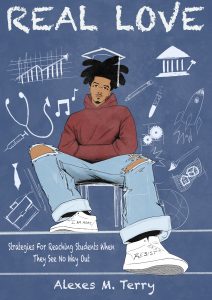The power of visualization in the classroom
I am a daydreamer by nature. I remember the days when I would stare off into space during 11th grade English. Heck, the walls were bland like my teacher’s teaching style so I would just sit and stare. While I was staring though, back then, I was scared to dream. The idea of dreaming kinda of felt like being in a Nightmare on Elm Street film; like if I closed my eyes, Freddie would come with his razor sharp hand and drag me into his fiery hell.
Closing my eyes and dreaming was scary because I quickly saw my reality–my momma was in jail, didn’t know when I’d see my dad, and I couldn’t escape the good memories of my cousin Lamar who was killed at the age of 15.
Yeah, dreaming was scary because my life felt like a nightmare at times. I was scared to ever dream or imagine a different reality than the one I was currently experiencing because for little girls from the hood like me, that mess always seemed impossible.
*sings Whitney Houston “Impossible! Impossible!”*
When a person is scared to dream, they must be taught that dreaming is possible. Teaching one to dream can start with one simple leading question:
If you could do and be anything in life, without any obstacles in your way, what would you do or become?
Yep, just like that…throw the question out there and…
CREATE SPACE
Dreaming can not happen if space is not created to dream. And, many of our students struggle with dreaming because we don’t create space or we’re taking up too much space with things irrelevant to who they are and what they want to become.
Are you creating space in your classroom for your students to dream and DREAM BIG?
Have you allowed yourself to DREAM and DREAM BIG?
Setting the tone for students to dream and vision can have a transformative impact on your classroom. Not only will it promote relationship building but it can also strengthen the learning community when students can share their deepest desires, hopes, and fears with each other. Space is created to see the commonalities, discuss the struggles, co-create solutions that will help everyone in the room to WIN and step into their fullest potential.
When we know our students’ hopes, dreams, and fears, we know how to tailor our instruction to help students overcome barriers and take the next right steps.
But again, for dreaming to happen, a designated time and space has to be created. Like, it has to be a whole VIBE! You feel me? Creating time and space for students to dream does not have to be complicated BUT it does have to be intentional.
When I am setting myself up for 5-10 minutes of visioning my future, here is my process:
- Grab a journal, pen, and colored pencils (because I like to doodle)
- Dim the lights and find a comfortable spot on the floor
- Turn on my Baroque music (or this meditation Spotify playlist from Headspace)
For 5 – 10 mins, I thinking on the following prompts and spend a few minutes, with my eyes closed, visualizing:
- Who is the person you want to come in 1 year?
- Who do you want to become in 3 years?
- What is the next right step I need to take today to become that person?
At the conclusion of my visualization time, I spend a few 2-3 minutes doing a QuickWrite where I jot down what I visualized. And from there, I create 3 action steps I can take IMMEDIATELY to move closer to who I want to be in the future.
So, what does this look like for students?
Model for your students how to visualize. Seeing you in that vulnerable space gives them permission to be vulnerable as well. After you have journaled your visualization, share with students what realistic action steps you will TAKE today to walk into your future.
For example, if you, or your students, want to experience joy–challenge yourself, or them, to do ONE thing now–such as tell a silly joke to a friend or listen to their favorite song–to move closer to joy.
The purpose of visualization in the classroom is to help students see future glimpses of themselves they never imagined and push their creativity and problem solving by challenging them to consider what can be done NOW to create the future they envision.
Our students’ visions have the possibility to solve world problems but these visions can not come to life if we don’t create space for them to SEE IT. WANT IT. DREAM IT. WORK HARD. AND GRIND UNTIL THEY OWN IT.
*Okay educators now let’s get in FORMATION*
I can’t wait to hear how you are creating space in your classroom for your students to visualize their future. And, I hope you incorporate this practice into your daily life. Connect with me on Instagram and let me know how you’re going to create space your students to visualize in your classroom.


